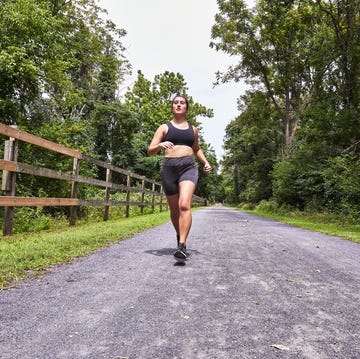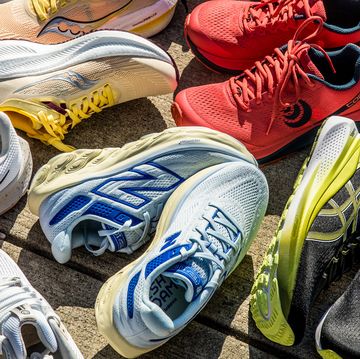If you like nothing more than waking up and heading straight out the door for an early-morning run without stopping to fuel up, then you practice fasted cardio. Or maybe you’ve just skipped a prerun snack because you didn’t have time to eat something before heading out on a run.
Either way, you may have heard that some research links fasted cardio to weight loss and performance benefits. But given that runners are encouraged to fuel up before runs, it’s crucial to separate the facts from the fiction. So here’s what experts want you to know about fasted cardio.
What is fasted cardio?
As the name implies, fasted cardio “literally just means doing a workout after not eating for some amount of time,” Lauren Antonucci, R.D.N., a board-certified specialist in sports dietetics based in New York tells Runner’s World.
Athletes may think that skipping lunch and heading straight from the office to a run is considered fasted cardio, but the science specifies that the body needs a 10- to 14-hour period of not eating to be truly fasted, Meghann Featherstone, R.D., a Cleveland-based board-certified specialist in sports dietetics, tells Runner’s World. So, for most people, fasted cardio would occur first thing in the morning.
That doesn’t mean you can’t have water or coffee (without cream or sugar), though, as long as they have no calories, according to a 2021 Nutrients article.
Are there benefits to fasted cardio?
When you fast, your liver glycogen stores decrease, and your body looks for alternative fuel sources. “Within a few minutes of starting a fasted workout—no matter how far you’re planning on running—the percentage of fat you would burn in that workout would be a little bit higher,” says Antonucci.
“If we run fasted, we tap into our fat stores as a fuel source sooner, so we’re running more on oxidized fat versus carbohydrates,” Featherstone explains.
Some research helps to demonstrate this source of fuel change that happens during fasted cardio. For example, a systematic review and meta-analysis published in 2016 in the British Journal of Nutrition states that an aerobic workout performed in a fasted state leads to greater fat oxidation, compared to a cardio workout done after eating.
Similarly, a study published in the International Journal of Environmental Research and Public Health in 2022, involving 12 male participants, found that fasting, even for just six hours, and then running on a treadmill for 20 minutes at a low to moderate intensity (45 to 65 percent of VO2 max) enhanced fat metabolism, when compared to running in a fed state.
What are the downsides to fasted cardio?
People tend to latch onto those concepts, and see fasted cardio as a path to weight loss (you’ll burn more fat!) or enhanced performance (if you can tap into fat stores for long periods, you’ll never hit the wall!).
When it comes to weight loss, all that fat-burning potential from fasted cardio does sound appealing. But “you’ll still be burning the same amount of calories,” says Antonucci. If you’re eating within the nutritional budget determined by your training plan and weight-loss goals, “burning a little bit higher percentage of fat is not really that important to your bodyweight over time or your body composition,” she says.
If you are doing fasted cardio, you will also likely not be able to work as hard or as long, considering your carbohydrate energy sources are limited. This means you will burn less overall calories in the workout, even if a slightly higher percentage of them are from fat. And if your main goal is weight loss, you want to maximize the calories burned from activity. (Plus, some people find they are more hungry after fasted exercise, which may lead to overeating.)
In terms of attaining a performance benefit by training fasted to avoid “hitting the wall,” there’s an association between carbohydrate intake and longer time to fatigue and better performance. Even at lower intensities, your body still relies on having some fuel coming in. Additionally, your brain and nervous system require glucose and low-glucose availability is a significant fatigue signal to your brain.
Also, after fasting, your body may not automatically burn fat instead of glucose; it may turn to protein. “Research shows that there’s an increase in muscle breakdown when we exercise fasted, so it could actually decrease our strength,” says Featherstone. This is because the body is in a stress state or catabolic, and one of the fastest ways for the body to make it’s own glucose is from protein breakdown.
While the research on protein metabolism in a fasted state is limited, one review article published in the Strength and Conditioning Journal in 2011 states that exercising in a fasted state yielded greater protein loss than in a non-fasted state, suggesting it might not be best for those looking to build muscle. Another scientific review published in 2020 states that while protein doesn’t provide much fuel for exercise on a regular basis, when you restrict calories, that contribution markedly increases.
Let’s not forget those endurance benefits of taking in calories: People were actually able to perform aerobically for longer after eating than when they fasted, a meta-analysis published in 2018 in the Scandinavian Journal of Medicine & Science in Sports found. And additional research shows that fasting has negative effects on the intensity and volume of training—both of which can hinder your performance.
“Intensity increases with our runs, and with that our dependence on carbs increases,” says Featherstone. “If we don’t have carbs to pull from, the intensity of our workout is going to suffer.”
Any time you do any high-intensity workout—intervals, fartleks, any speedwork—you’re going to burn a super high percentage of carbs no matter what. “Not fueling beforehand just shortchanges your energy and ability to work hard,” says Antonucci.
Plus, your rate of perceived exertion is much higher at a lower intensity when you run off fat versus carbs, says Featherstone, and you’re likely to finish fasted high-intensity runs feeling terrible or even hit a wall sooner in longer efforts.
Finally, for more definitive answers for the benefits of fasted cardio, we need more long-term and bigger studies following different populations. A review paper published in the Proceedings of the Nutrition Society in 2018, points out that while fasted cardio enhances fat metabolism, we still need to know how that might affect those with cardio-metabolic conditions and how training in a fasted state might affect outcomes when doing other types of workouts, like resistance training.
So should you try fasted cardio?
If you’d rather use your prerun time in the morning to sleep in a little bit or you can’t handle the idea of eating early in the morning, sure, it’s okay to do fasted cardio. “Just make sure you’re only doing easy runs when you’re in a fasted state,” says Featherstone. Because of limited glycogen, don’t regularly plan long (90 or more minutes) or hard workouts when fasted.
Otherwise, when it comes to really putting in the work, it’s better to run within one to three hours after eating breakfast. “Running isn’t just about burning fat,” says Antonucci. “When you’re properly fueled, it’s going to feel better mentally and physically.”

Dr. Namrita Brooke is a full-time endurance sport coach and sport nutritionist advising active individuals and amateurs to professional athletes. She is also an adjunct professor in the Department of Movement Sciences and Health at University of West Florida. Professionally, she also serves on the Board of Editors of the Sports Nutrition Care Manual and remains involved in nutrition and exercise-related research, student mentorship, and coach development. Namrita's personal athletic experience ranges from ultra-endurance mountain biking to off-road triathlon, cross-country mountain bike racing, gravel cycling, duathlon, cyclocross, running, and trail running. Her research background includes hydration and sports drink research, and the interaction of nutrition, physical activity, and the brain.













